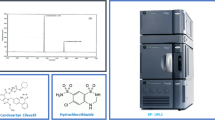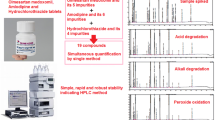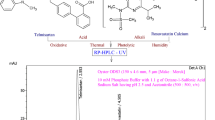Abstract
A RP-LC method was developed and validated for simultaneous determination of the active components, azilsartan medoxomil (AZL) and chlorthalidone (CLT), in their novel antihypertensive combined recipe. The chromatographic separation was achieved on an Eclipse XDB-C18 (4.6 × 150 mm, 5 μm) column using a mobile phase consisting of methanol/potassium hydrogen phosphate buffer (pH 8, 0.05 M) (40:60, v/v) in isocratic mode. The flow rate was maintained at 0.8 mL min−1 at ambient temperature. Detection was carried out at 210 nm. The method was validated according to the ICH guidelines. Linearity, accuracy, and precision were satisfactory over the concentration range of 5.0–50.0 and 2.5–25.0 μg mL−1 for AZL and CLT, respectively (r 2 = 0.9999). LODs for AZL and CLT were 0.90 and 0.32 μg mL−1, whereas LOQs were 2.72 and 0.98 μg mL−1, respectively. Both drugs were subjected to forced degradation studies under hydrolysis (neutral, acidic, and alkaline), oxidative, and photolytic extensive stress conditions. The proposed method is stability indicating by the resolution of the investigated drugs from their degradation products. Moreover, the kinetics of the acidic degradation of AZL as well as the kinetics of the alkaline degradation of CLT were investigated. Arrhenius plots were constructed and the apparent first-order rate constants, half-life times, shelf-life times, and the activation energies of the degradation processes were calculated. The method was successfully applied for the determination of the studied drugs simultaneously in their coformulated tablet. The developed method is specific and stability indicating for the quality control and routine analysis of the cited medications in their pharmaceutical preparations.









Similar content being viewed by others
References
Baker WL, White WB (2011) Azilsartan medoxomil: a new angiotensin II receptor antagonist for treatment of hypertension. Ann Pharmacother 45:1506–1515. doi:10.1345/aph.1Q468
Kurtz TW, Kajiya T (2012) Differential pharmacology and benefit/risk of azilsartan compared to other sartans. Vasc Health Risk Manag 8:133–143
Kusumoto K, Igata H, Ojima M, Tsuboi A, Imanishi M, Yamaguchi F, Sakamoto H, Kuroita T, Kawaguchi N, Nishigaki N, Nagaya H (2011) Antihypertensive, insulin-sensitising and renoprotective effects of a novel, potent and long-acting angiotensin II type 1 receptor blocker, azilsartan medoxomil, in rat and dog models. Eur J Pharmacol 669:84–93
Vekariya PP, Joshi HS (2013) Development and validation of RP-HPLC method for azilsartan medoxomil potassium quantitation in human plasma by solid phase extraction procedure. ISRN Spectrosc 2013:6. doi:10.1155/2013/572170
Sweetman S (2009) Martindale: the complete drug reference, 36th edn. The Pharmaceutical Press, London
Singh B, Patel DK, Ghosh SK (2009) A reversed-phase high performance liquid chromatographic method for determination of chlorthalidone in pharmaceutical formulation. Int J Pharm Sci 1:24–29
Mhaske RA, Sahasrabudhe S, Mhaske AA, Garole DJ (2012) RP-HPLC method for simultataneous determination of atorvastatin calcium, olmesartan medoxomil, candesartan, hydrochlorothiazide and chlorthalidone - application to commercially available drug products. Int J Pharm Sci Res 3:793–801
Woo H, Kim JW, Han KM, Lee JH, Hwang IS, Kim J, Kweon SJ, Cho S, Chae KR, Han SY (2013) Simultaneous analysis of 17 diuretics in dietary supplements by HPLC and LC-MS/MS. Food Addit Contam, Part A 30:209–217. doi:10.1080/19440049.2012.738939
Youssef RM, Maher HM, El-Kimary EI, Hassan EM, Barary MH (2013) Validated stability-indicating methods for the simultaneous determination of amiloride hydrochloride, atenolol, and chlorthalidone using HPTLC and HPLC with photodiode array detector. J AOAC Int 96:313–323. doi:10.5740/jaoacint.11-347
Salem H (2004) High-performance thin-layer chromatography for the determination of certain antihypertensive mixtures. Sci Pharm 72:157–174
Ciborowski M, Icardo MC, Mateo JV, Martinez Calatayud J (2004) FI-chemiluminometric study of thiazides by on-line photochemical reaction. J Pharm Biomed Anal 36:693–700. doi:10.1016/j.jpba.2004.08.020
Parmar KE, Mehta RS (2013) First order derivative spectrophotometric method for simultaneous estimation of telmisartan and chlorthalidone in bulk and pharmaceutical dosage form. Int Res J Pharm 4:224–228. doi:10.7897/2230-8407.04348
Lu M, Li X, Feng Q, Chen G, Zhang L (2010) Analysis of diuretics by capillary electrochromatography using poly(1-hexadecene-co-TMPTMA) monolithic column. Sepu 28:253–259. doi:10.3724/sp.j.1123.2010.00253
Cheng JWM (2013) Azilsartan/chlorthalidone combination therapy for blood pressure control. Integr Blood Press Control 6:39–48. doi:10.2147/ibpc.s34792
Kasimala MB, Kasimala BB (2012) Reverse phase-HPLC method development and validation for the simultaneous estimation of azilsartan medoxomil and chlorthalidone in pharmaceutical dosage forms. Jamonline 2:117–126
ICH (1996) International Conference on Harmonization of technical requirements for registration of pharmaceuticals for human use. ICH Harmonised Tripartite Guideline Q1A(R2) and (Q1B), Stability testing of new drug substances and products, 2003 and stability testing: photostability testing of new drug substances and products. ICH: Geneva, Switzerland
ICH (2013) Harmonized tripartite guideline, validation of analytical procedures: text and methodology, Q2(R1), current step 4 version, parent guidelines on methodology. Dated November 6 1996, Incorporated in November 2005. http://www.ich.org/fileadmin/Public_Web_Site/ICH_Products/Guidelines/Quality/Q2_R1/Step4/Q2_R1__Guideline.pdf. Accessed April 23
Sinko PJ (2011) Martin’s physical pharmacy and pharmaceutical sciences: physical chemical and biopharmaceutical principles in the pharmaceutical sciences. 6th ed. Lippincott, Philadelphia, PA
Acknowledgments
We gratefully acknowledge the financial support received from Cultural Affairs and Mission Sector (Egyptian Government) for Joint Supervision mission (JS 2756).
Author information
Authors and Affiliations
Corresponding author
Electronic supplementary material
Below is the link to the electronic supplementary material.
ESM 1
PDF 1.64 mb
Rights and permissions
About this article
Cite this article
Ebeid, W.M., Elkady, E.F., El-Zaher, A.A. et al. Stability-indicating RP-LC method for determination of azilsartan medoxomil and chlorthalidone in pharmaceutical dosage forms: application to degradation kinetics. Anal Bioanal Chem 406, 6701–6712 (2014). https://doi.org/10.1007/s00216-014-8085-0
Received:
Revised:
Accepted:
Published:
Issue Date:
DOI: https://doi.org/10.1007/s00216-014-8085-0




